A New Multiple Phenological Spectral Feature for Mapping Winter Wheat
Abstract
:1. Introduction
2. Materials and Methods
2.1. Study Area
2.2. Datasets
2.2.1. Sentinel-2 Imagery
2.2.2. Reference Data
- (1)
- Visual interpreting of winter wheat samples. Due to the spread of COVID-19 and restrictions on epidemic prevention policies, we were unable to obtain the latest field survey data for the study area. Fortunately, Google Earth’s ability to provide very high-resolution data and historical images solved the limitation of lack of samples in the field. Some previous studies have proved that the very high-resolution imagery in GE is an effective data source to collect samples [25,26,27]. A total of 1158 ROIs, including 1023 winter wheat ROIs (155,853 pixels) and 135 non-winter wheat ROIs (389,848 pixels), were obtained through comparison and visual interpretation of multi-phenological images in the study area. Half of the winter wheat samples were used to train one-class classifiers, and the other half of the winter wheat samples and non-winter wheat samples were used to verify mapping accuracy. Non-winter wheat samples included non-vegetation types (e.g., urban (26 ROIs, 45,087 pixels), water (14 ROIs, 25,091 pixels), wasteland (27 ROIs, 46,780 pixels)), and other vegetation types (e.g., other crops (202 ROIs, 136,440 pixels), woodland (43 ROIs, 81,870 pixels), grassland (67 ROIs, 54,580 pixels)). Among the vegetation types, half were agricultural areas and the remaining half were woodland and grassland. The number of training and validation ROIs of the 11 districts that planted winter wheat in Beijing (ranking source: official data from BBS) are listed in Table 1. It should be noted that different ROIs consisted of different numbers of pixels. If samples were collected in a large area, with the same land cover type, it was easy to draw a complete polygon in GE, resulting in the number of ROIs being small, such as the sample selection of mountain areas (e.g., Pinggu, Huairou, Miyun, Yanqing), as well as urban areas (e.g., Haidian, Chaoyang).
- (2)
- Winter wheat area statistics from the BBS. The planting area data of winter wheat in each district of Beijing can be accessed from the statistical yearbook published by the Beijing Bureau of Statistics (http://tjj.beijing.gov.cn/ (accessed on 24 July 2022)). Since statistical yearbooks generally report the data of the previous year in the later year, and winter wheat is harvested in the summer of the year after sowing in the autumn of the previous year, according to the time interval for winter wheat in our study (2018–2020), the statistical yearbooks of Beijing in 2019 and 2020 (published in 2020 and 2021, respectively) should be queried.
- (3)
- An open-source 30-m winter wheat-mapping product in the Beijing area. Paper [17] produced a 30-m mapping of the early-season winter wheat in 11 provinces in China, which is one of the most winter wheat-accurate mapping data available in Beijing region. Thus, it was selected as auxiliary data to verify the mapping accuracy for this work.
2.3. Methods
2.3.1. Multiple Phenological Spectral Feature (Mpsf) Composite Method
Cloud Masking
Identifying Key Phenological Periods
- (1)
- Sowing period. At this stage, the vegetation coverage of the land was low and soil signals emerged. In October, BSI showed a series of high values, while NDVI was at a low value, indicating that the land was not covered by obvious vegetation (Figure 4a).
- (2)
- Growth period. Before the overwintering period (from mid-December to late February of the following year), winter wheat grew slowly. After the overwintering period, winter wheat entered the stage of rapid growth, and its chlorophyll signal increased sharply and reached the peak of the whole phenological period, as shown in the spectral profile of NDVI (Figure 4b). In this period, the values of BSI and PSRI were at their nadir.
- (3)
- Mature period. From late May, winter wheat began to mature. At this time, chlorophyll content decreased sharply while carotenoids increased, and the corresponding spectral index changes were shown in Figure 4b,c. With the harvest of winter wheat, large areas of winter wheat fields were bare (soil signal appeared again), and at the same time, the value of BSI increased significantly (as shown in Figure 4a).
Image Composite Method for New Feature Based on Key Phenological Periods
2.3.2. Spectral Separability Evaluation
2.3.3. One-Class Classifier
2.4. Accuracy Assessment
3. Results
3.1. Spectral Separability
3.2. Classification Accuracy
3.2.1. Compare with Winter Wheat Sample Data
3.2.2. Compare with Data from BBS
3.2.3. Compare with a 30 m Winter Wheat-Mapping Product
4. Discussion
4.1. Three Key Phenological Periods
4.2. Six Key Spectral Indices
4.3. One-Class Classifier
4.4. Implications and Uncertainty of the Winter Wheat Map
5. Conclusions
Author Contributions
Funding
Data Availability Statement
Acknowledgments
Conflicts of Interest
References
- Han, N.A.; Zhang, B.Z.; Liu, Y.; Peng, Z.G.; Zhou, Q.Y.; Wei, Z. Rapid Diagnosis of Nitrogen Nutrition Status in Summer Maize over Its Life Cycle by a Multi-Index Synergy Model Using Ground Hyperspectral and UAV Multispectral Sensor Data. Atmosphere 2022, 13, 122. [Google Scholar] [CrossRef]
- Fan, M.; Miao, F.; Jia, H.; Li, G.; Powers, C.; Nagarajan, R.; Alderman, P.D.; Carver, B.F.; Ma, Z.; Yan, L. O-linked N-acetylglucosamine transferase is involved in fine regulation of flowering time in winter wheat. Nat. Commun. 2021, 12, 2303. [Google Scholar] [CrossRef] [PubMed]
- Dong, Q.; Chen, X.; Chen, J.; Zhang, C.; Liu, L.; Cao, X.; Zang, Y.; Zhu, X.; Cui, X. Mapping Winter Wheat in North China Using Sentinel 2A/B Data: A Method Based on Phenology-Time Weighted Dynamic Time Warping. Remote Sens. 2020, 12, 1274. [Google Scholar] [CrossRef]
- Li, C.; Chen, W.; Wang, Y.; Wang, Y.; Ma, C.; Li, Y.; Li, J.; Zhai, W. Mapping Winter Wheat with Optical and SAR Images Based on Google Earth Engine in Henan Province, China. Remote Sens. 2022, 14, 284. [Google Scholar] [CrossRef]
- Useya, J.; Chen, S. Exploring the Potential of Mapping Cropping Patterns on Smallholder Scale Croplands Using Sentinel-1 SAR Data. Chin. Geogr. Sci. 2019, 29, 626–639. [Google Scholar] [CrossRef]
- Tiwari, V.; Matin, M.A.; Qamer, F.M.; Ellenburg, W.L.; Bajracharya, B.; Vadrevu, K.; Rushi, B.R.; Yusafi, W. Wheat Area Mapping in Afghanistan Based on Optical and SAR Time-Series Images in Google Earth Engine Cloud Environment. Front. Environ. Sci. 2020, 8, 77. [Google Scholar] [CrossRef]
- Mercier, A.; Betbeder, J.; Baudry, J.; Le Roux, V.; Spicher, F.; Lacoux, J.; Roger, D.; Hubert-Moy, L. Evaluation of Sentinel-1 & 2 time series for predicting wheat and rapeseed phenological stages. ISPRS J. Photogramm. Remote Sens. 2020, 163, 231–256. [Google Scholar] [CrossRef]
- Zhou, T.; Pan, J.; Zhang, P.; Wei, S.; Han, T. Mapping Winter Wheat with Multi-Temporal SAR and Optical Images in an Urban Agricultural Region. Sensors 2017, 17, 1210. [Google Scholar] [CrossRef]
- Ni, R.; Tian, J.; Li, X.; Yin, D.; Li, J.; Gong, H.; Zhang, J.; Zhu, L.; Wu, D. An enhanced pixel-based phenological feature for accurate paddy rice mapping with Sentinel-2 imagery in Google Earth Engine. ISPRS J. Photogramm. Remote Sens. 2021, 178, 282–296. [Google Scholar] [CrossRef]
- Liang, S.; Wang, J.; Jiang, B. Chapter 1—A systematic view of remote sensing. In Advanced Remote Sensing, 2nd ed.; Liang, S., Wang, J., Eds.; Academic Press: Cambridge, MA, USA, 2020; pp. 1–57. [Google Scholar]
- Liu, W.; Huang, J.; Wei, C.; Wang, X.; Mansaray, L.R.; Han, J.; Zhang, D.; Chen, Y. Mapping water-logging damage on winter wheat at parcel level using high spatial resolution satellite data. ISPRS J. Photogramm. Remote Sens. 2018, 142, 243–256. [Google Scholar] [CrossRef]
- Yuan, L.; Zhang, J.; Shi, Y.; Nie, C.; Wei, L.; Wang, J. Damage Mapping of Powdery Mildew in Winter Wheat with High-Resolution Satellite Image. Remote Sens. 2014, 6, 3611–3623. [Google Scholar] [CrossRef]
- Yang, Y.; Tao, B.; Ren, W.; Zourarakis, D.P.; El Masri, B.; Sun, Z.; Tian, Q. An Improved Approach Considering Intraclass Variability for Mapping Winter Wheat Using Multitemporal MODIS EVI Images. Remote Sens. 2019, 11, 1191. [Google Scholar] [CrossRef]
- Tao, J.-B.; Wu, W.-B.; Zhou, Y.; Wang, Y.; Jiang, Y. Mapping winter wheat using phenological feature of peak before winter on the North China Plain based on time-series MODIS data. J. Integr. Agric. 2017, 16, 348–359. [Google Scholar] [CrossRef]
- Ren, S.; Guo, B.; Wu, X.; Zhang, L.; Ji, M.; Wang, J. Winter wheat planted area monitoring and yield modeling using MODIS data in the Huang-Huai-Hai Plain, China. Comput. Electron. Agric. 2021, 182, 106049. [Google Scholar] [CrossRef]
- Li, F.; Ren, J.; Wu, S.; Zhao, H.; Zhang, N. Comparison of Regional Winter Wheat Mapping Results from Different Similarity Measurement Indicators of NDVI Time Series and Their Optimized Thresholds. Remote Sens. 2021, 13, 1162. [Google Scholar] [CrossRef]
- Dong, J.; Fu, Y.; Wang, J.; Tian, H.; Fu, S.; Niu, Z.; Han, W.; Zheng, Y.; Huang, J.; Yuan, W. Early-season mapping of winter wheat in China based on Landsat and Sentinel images. Earth Syst. Sci. Data 2020, 12, 3081–3095. [Google Scholar] [CrossRef]
- Meng, S.; Zhong, Y.; Luo, C.; Hu, X.; Wang, X.; Huang, S. Optimal Temporal Window Selection for Winter Wheat and Rapeseed Mapping with Sentinel-2 Images: A Case Study of Zhongxiang in China. Remote Sens. 2020, 12, 226. [Google Scholar] [CrossRef]
- Hunt, M.L.; Blackburn, G.A.; Carrasco, L.; Redhead, J.W.; Rowland, C.S. High resolution wheat yield mapping using Sentinel-2. Remote Sens. Environ. 2019, 233, 111410. [Google Scholar] [CrossRef]
- Qu, C.; Li, P.; Zhang, C. A spectral index for winter wheat mapping using multi-temporal Landsat NDVI data of key growth stages. ISPRS J. Photogramm. Remote Sens. 2021, 175, 431–447. [Google Scholar] [CrossRef]
- Wang, C.; Zhang, H.; Wu, X.; Yang, W.; Shen, Y.; Lu, B.; Wang, J. AUTS: A Novel Approach to Mapping Winter Wheat by Automatically Updating Training Samples Based on NDVI Time Series. Agriculture 2022, 12, 817. [Google Scholar] [CrossRef]
- Pan, L.; Xia, H.; Zhao, X.; Guo, Y.; Qin, Y. Mapping Winter Crops Using a Phenology Algorithm, Time-Series Sentinel-2 and Landsat-7/8 Images, and Google Earth Engine. Remote Sens. 2021, 13, 2510. [Google Scholar] [CrossRef]
- Liu, L.; Cao, R.; Chen, J.; Shen, M.; Wang, S.; Zhou, J.; He, B. Detecting crop phenology from vegetation index time-series data by improved shape model fitting in each phenological stage. Remote Sens. Environ. 2022, 277, 113060. [Google Scholar] [CrossRef]
- Jiang, L.; Shang, S.; Yang, Y.; Guan, H. Mapping interannual variability of maize cover in a large irrigation district using a vegetation index—Phenological index classifier. Comput. Electron. Agric. 2016, 123, 351–361. [Google Scholar] [CrossRef]
- Zhang, X.; Xiao, X.; Wang, X.; Xu, X.; Chen, B.; Wang, J.; Ma, J.; Zhao, B.; Li, B. Quantifying expansion and removal of Spartina alterniflora on Chongming island, China, using time series Landsat images during 1995–2018. Remote Sens. Environ. 2020, 247, 111916. [Google Scholar] [CrossRef] [PubMed]
- Kennedy, R.E.; Yang, Z.; Cohen, W.B. Detecting trends in forest disturbance and recovery using yearly Landsat time series: 1. LandTrendr—Temporal segmentation algorithms. Remote Sens. Environ. 2010, 114, 2897–2910. [Google Scholar] [CrossRef]
- Huang, C.; Goward, S.N.; Masek, J.G.; Thomas, N.; Zhu, Z.; Vogelmann, J.E. An automated approach for reconstructing recent forest disturbance history using dense Landsat time series stacks. Remote Sens. Environ. 2010, 114, 183–198. [Google Scholar] [CrossRef]
- Hermosilla, T.; Wulder, M.; White, J.; Coops, N.C.; Hobart, G.W.; Campbell, L.B. Mass data processing of time series Landsat imagery: Pixels to data products for forest monitoring. Int. J. Digit. Earth 2016, 9, 1035–1054. [Google Scholar] [CrossRef]
- Tian, J.; Wang, L.; Yin, D.; Li, X.; Diao, C.; Gong, H.; Shi, C.; Menenti, M.; Ge, Y.; Nie, S.; et al. Development of spectral-phenological features for deep learning to understand Spartina alterniflora invasion. Remote Sens. Environ. 2020, 242, 111745. [Google Scholar] [CrossRef]
- Weigand, M.; Staab, J.; Wurm, M.; Taubenböck, H. Spatial and semantic effects of LUCAS samples on fully automated land use/land cover classification in high-resolution Sentinel-2 data. Int. J. Appl. Earth Obs. Geoinf. 2020, 88, 102065. [Google Scholar] [CrossRef]
- Polykretis, C.; Grillakis, M.; Alexakis, D. Exploring the Impact of Various Spectral Indices on Land Cover Change Detection Using Change Vector Analysis: A Case Study of Crete Island, Greece. Remote Sens. 2020, 12, 319. [Google Scholar] [CrossRef] [Green Version]
- Chu, H.; Venevsky, S.; Wu, C.; Wang, M. NDVI-based vegetation dynamics and its response to climate changes at Amur-Heilongjiang River Basin from 1982 to 2015. Sci. Total Environ. 2018, 650, 2051–2062. [Google Scholar] [CrossRef]
- De Castro, A.I.; Six, J.; Plant, R.E.; Peña, J.M. Mapping Crop Calendar Events and Phenology-Related Metrics at the Parcel Level by Object-Based Image Analysis (OBIA) of MODIS-NDVI Time-Series: A Case Study in Central California. Remote Sens. 2018, 10, 1745. [Google Scholar] [CrossRef]
- Merzlyak, M.N.; Gitelson, A.A.; Chivkunova, O.B.; Rakitin, V.Y. Non-destructive optical detection of pigment changes during leaf senescence and fruit ripening. Physiol. Plant. 1999, 106, 135–141. [Google Scholar] [CrossRef]
- Ren, S.; Chen, X.; An, S. Assessing plant senescence reflectance index-retrieved vegetation phenology and its spatiotemporal response to climate change in the Inner Mongolian Grassland. Int. J. Biometeorol. 2016, 61, 601–612. [Google Scholar] [CrossRef]
- Chen, J.; Jönsson, P.; Tamura, M.; Gu, Z.; Matsushita, B.; Eklundh, L. A simple method for reconstructing a high-quality NDVI time-series data set based on the Savitzky–Golay filter. Remote Sens. Environ. 2004, 91, 332–344. [Google Scholar] [CrossRef]
- Bera, B.; Saha, S.; Bhattacharjee, S. Forest cover dynamics (1998 to 2019) and prediction of deforestation probability using binary logistic regression (BLR) model of Silabati watershed, India. Trees For. People 2020, 2, 100034. [Google Scholar] [CrossRef]
- Tucker, C.J. Red and photographic infrared linear combinations for monitoring vegetation. Remote Sens. Environ. 1979, 8, 127–150. [Google Scholar] [CrossRef]
- Niu, Q.L.; Feng, H.K.; Zhou, X.G.; Zhu, J.Q.; Yong, B.B.; Li, H.Z. Combining UAV Visible Light and Multispectral Vegetation Indices for Estimating SPAD Value of Winter Wheat. Trans. Chin. Soc. Agric. Mach. 2021, 52, 183–194. [Google Scholar]
- Chen, S.X.; Xu, X.G.; Xu, L.J.; Yang, G.J.; Xing, H.M.; He, P. Estimating Vegetation Coverage of Winter Wheat Based on New Vegetation Index. J. Triticeae Crops 2016, 36, 939–944. [Google Scholar]
- Huete, A.; Didan, K.; Miura, T.; Rodriguez, E.P.; Gao, X.; Ferreira, L.G. Overview of the radiometric and biophysical performance of the MODIS vegetation indices. Remote Sens. Environ. 2002, 83, 195–213. [Google Scholar] [CrossRef]
- Huete, A.R.; Liu, H.Q.; Batchily, K.V.; van Leeuwen, W. A comparison of vegetation indices over a global set of TM images for EOS-MODIS. Remote Sens. Environ. 1997, 59, 440–451. [Google Scholar] [CrossRef]
- Khan, A.; Hansen, M.C.; Potapov, P.V.; Adusei, B.; Pickens, A.; Krylov, A.; Stehman, S.V. Evaluating Landsat and RapidEye Data for Winter Wheat Mapping and Area Estimation in Punjab, Pakistan. Remote Sens. 2018, 10, 489. [Google Scholar] [CrossRef] [Green Version]
- Tian, H.; Pei, J.; Huang, J.; Li, X.; Wang, J.; Zhou, B.; Qin, Y.; Wang, L. Garlic and Winter Wheat Identification Based on Active and Passive Satellite Imagery and the Google Earth Engine in Northern China. Remote Sens. 2020, 12, 3539. [Google Scholar] [CrossRef]
- Darvishzadeh, R.; Skidmore, A.; Schlerf, M.; Atzberger, C.; Corsi, F.; Cho, M. LAI and chlorophyll estimation for a heterogeneous grassland using hyperspectral measurements. ISPRS J. Photogramm. Remote Sens. 2008, 63, 409–426. [Google Scholar] [CrossRef]
- Kawashima, S.; Nakatani, M. An Algorithm for Estimating Chlorophyll Content in Leaves Using a Video Camera. Ann. Bot. 1998, 81, 49–54. [Google Scholar] [CrossRef]
- Wang, Z.X.; Liu, C.; Alfredo, H. From AVHRR-NDVI to MODIS-EVI: Advances in vegetation index research. Acta Ecol. Sin. 2003, 23, 979–987. [Google Scholar]
- Chen, Y.Y. The Main Tree Species in Typital Areas of Beijing Regulate the Air Quality and Ecological Function. Master’s Thesis, University of Agriculture, Beijing, China, 2019. [Google Scholar]
- Li, F.; Xie, L.; Wang, H.; Qin, Q.; Zhao, H. Extraction and annual variation dynamic monitoring of winter wheat area based on GF-1 images. Shandong Agric. Sci. 2017, 49, 139–144. [Google Scholar] [CrossRef]
- Tolpekin, V.A.; Stein, A. Quantification of the Effects of Land-Cover-Class Spectral Separability on the Accuracy of Markov-Random-Field-Based Superresolution Mapping. IEEE Trans. Geosci. Remote Sens. 2009, 47, 3283–3297. [Google Scholar] [CrossRef]
- Wang, Y.; Qi, Q.; Liu, Y. Unsupervised Segmentation Evaluation Using Area-Weighted Variance and Jeffries-Matusita Distance for Remote Sensing Images. Remote Sens. 2018, 10, 1193. [Google Scholar] [CrossRef]
- Schmidt, K.; Skidmore, A. Spectral discrimination of vegetation types in a coastal wetland. Remote Sens. Environ. 2003, 85, 92–108. [Google Scholar] [CrossRef]
- Zhang, H.; Du, H.; Zhang, C.; Zhang, L. An automated early-season method to map winter wheat using time-series Sentinel-2 data: A case study of Shandong, China. Comput. Electron. Agric. 2021, 182, 105962. [Google Scholar] [CrossRef]
- Schölkopf, B.; Platt, J.C.; Shawe-Taylor, J.; Smola, A.J.; Williamson, R.C. Estimating the Support of a High-Dimensional Distribution. Neural Comput. 2001, 13, 1443–1471. [Google Scholar] [CrossRef] [PubMed]
- Yang, G.; Yu, W.; Yao, X.; Zheng, H.; Cao, Q.; Zhu, Y.; Cao, W.; Cheng, T. AGTOC: A novel approach to winter wheat mapping by automatic generation of training samples and one-class classification on Google Earth Engine. Int. J. Appl. Earth Obs. Geoinform. 2021, 102, 102446. [Google Scholar] [CrossRef]
- Chang, C.; Lin, C. LIBSVM: A Library for Support Vector Machines. ACM Trans. Intell. Syst. Technol. 2011, 2, 1–27. [Google Scholar] [CrossRef]
- Xiao, Y.; Wang, H.; Xu, W. Parameter Selection of Gaussian Kernel for One-Class SVM. IEEE Trans. Cybern. 2014, 45, 941–953. [Google Scholar] [CrossRef]
- Gorelick, N.; Hancher, M.; Dixon, M.; Ilyushchenko, S.; Thau, D.; Moore, R. Google Earth Engine: Planetary-scale geospatial analysis for everyone. Remote Sens. Environ. 2017, 202, 18–27. [Google Scholar] [CrossRef]
- Dong, J.; Fu, Y.; Wang, J.; Tian, H.; Fu, S.; Niu, Z.; Han, W.; Zheng, Y.; Huang, J.; Yaun, W. 30 m Winter Wheat Distribution Map of China for Four Years (2016–2019). figshare 2020. [Google Scholar] [CrossRef]
- Foody, G.M. Impacts of ignorance on the accuracy of image classification and thematic mapping. Remote Sens. Environ. 2021, 259, 112367. [Google Scholar] [CrossRef]
- Lu, L.L.; Wang, C.Z.; Guo, H.D.; Li, Q.T. Detecting winter wheat phenology with SPOT-VEGETATION data in the North China Plain. Geocarto Int. 2014, 29, 244–255. [Google Scholar] [CrossRef]
- Tian, J.; Zhu, X.; Shen, Z.; Wu, J.; Xu, S.; Liang, Z.; Wang, J. Investigating the urban-induced microclimate effects on winter wheat spring phenology using Sentinel-2 time series. Agric. For. Meteorol. 2020, 294, 108153. [Google Scholar] [CrossRef]
- Song, Y.; Wang, J. Mapping Winter Wheat Planting Area and Monitoring Its Phenology Using Sentinel-1 Backscatter Time Series. Remote Sens. 2019, 11, 449. [Google Scholar] [CrossRef]
- Qiu, B.; Luo, Y.; Tang, Z.; Chen, C.; Lu, D.; Huang, H.; Chen, Y.; Chen, N.; Xu, W. Winter wheat mapping combining variations before and after estimated heading dates. ISPRS J. Photogramm. Remote Sens. 2017, 123, 35–46. [Google Scholar] [CrossRef]
- Cai, Y.; Lin, H.; Zhang, M. Mapping paddy rice by the object-based random forest method using time series Sentinel-1/Sentinel-2 data. Adv. Space Res. 2019, 64, 2233–2244. [Google Scholar] [CrossRef]
- Anderegg, J.; Yu, K.; Aasen, H.; Walter, A.; Liebisch, F.; Hund, A. Spectral Vegetation Indices to Track Senescence Dynamics in Diverse Wheat Germplasm. Front. Plant Sci. 2020, 10, 1749. [Google Scholar] [CrossRef] [PubMed]
- Wang, D.L.; Zhang, A.B.; Zhao, A.Z.; Li, J. Extraction model of winter wheat planting information based on unsupervised classification. Bull. Surv. Mapp. 2019, 8, 68–71+77. [Google Scholar] [CrossRef]
- Bera, B.; Saha, S.; Bhattacharjee, S. Estimation of Forest Canopy Cover and Forest Fragmentation Mapping Using Landsat Satellite Data of Silabati River Basin (India). KN-J. Cartogr. Geogr. Inf. 2020, 70, 181–197. [Google Scholar] [CrossRef]
- Pastor-Guzman, J.; Dash, J.; Atkinson, P.M. Remote sensing of mangrove forest phenology and its environmental drivers. Remote Sens. Environ. 2018, 205, 71–84. [Google Scholar] [CrossRef]
- Azzari, G.; Lobell, D. Landsat-based classification in the cloud: An opportunity for a paradigm shift in land cover monitoring. Remote Sens. Environ. 2017, 202, 64–74. [Google Scholar] [CrossRef]
- Bey, A.; Jetimane, J.; Lisboa, S.N.; Ribeiro, N.; Sitoe, A.; Meyfroidt, P. Mapping smallholder and large-scale cropland dynamics with a flexible classification system and pixel-based composites in an emerging frontier of Mozambique. Remote Sens. Environ. 2020, 239, 111611. [Google Scholar] [CrossRef]
- Flood, N. Seasonal Composite Landsat TM/ETM+ Images Using the Medoid (a Multi-Dimensional Median). Remote Sens. 2013, 5, 6481–6500. [Google Scholar] [CrossRef]
- Jin, Z.; Azzari, G.; You, C.; Di Tommaso, S.; Aston, S.; Burke, M.; Lobell, D.B. Smallholder maize area and yield mapping at national scales with Google Earth Engine. Remote Sens. Environ. 2019, 228, 115–128. [Google Scholar] [CrossRef]
- Mack, B.; Roscher, R.; Stenzel, S.; Feilhauer, H.; Schmidtlein, S.; Waske, B. Mapping raised bogs with an iterative one-class classification approach. ISPRS J. Photogramm. Remote Sens. 2016, 120, 53–64. [Google Scholar] [CrossRef]
- Zhao, L.; Li, Q.; Zhang, Y.; Du, X.; Wang, H.; Shen, Y. Study on the potential of whitening transformation in improving single crop mapping accuracy. J. Appl. Remote Sens. 2019, 13, 034512. [Google Scholar] [CrossRef]
- Sun, H.; Li, S.; Li, M.Z.; Liu, H.J.; Qiao, L.; Zhang, Y. Research Progress of Image Sensing and Deep Learning in Agriculture. Trans. Chin. Soc. Agric. Mach. 2020, 51, 1–17. [Google Scholar]
- Cai, W. Wheat Identification and Area Estimation Based on Mixed Image Element Decomposition of MODIS Remote Sensing Data. Master’s Thesis, Shandong Normal University, Jinan, China, 2010. [Google Scholar]
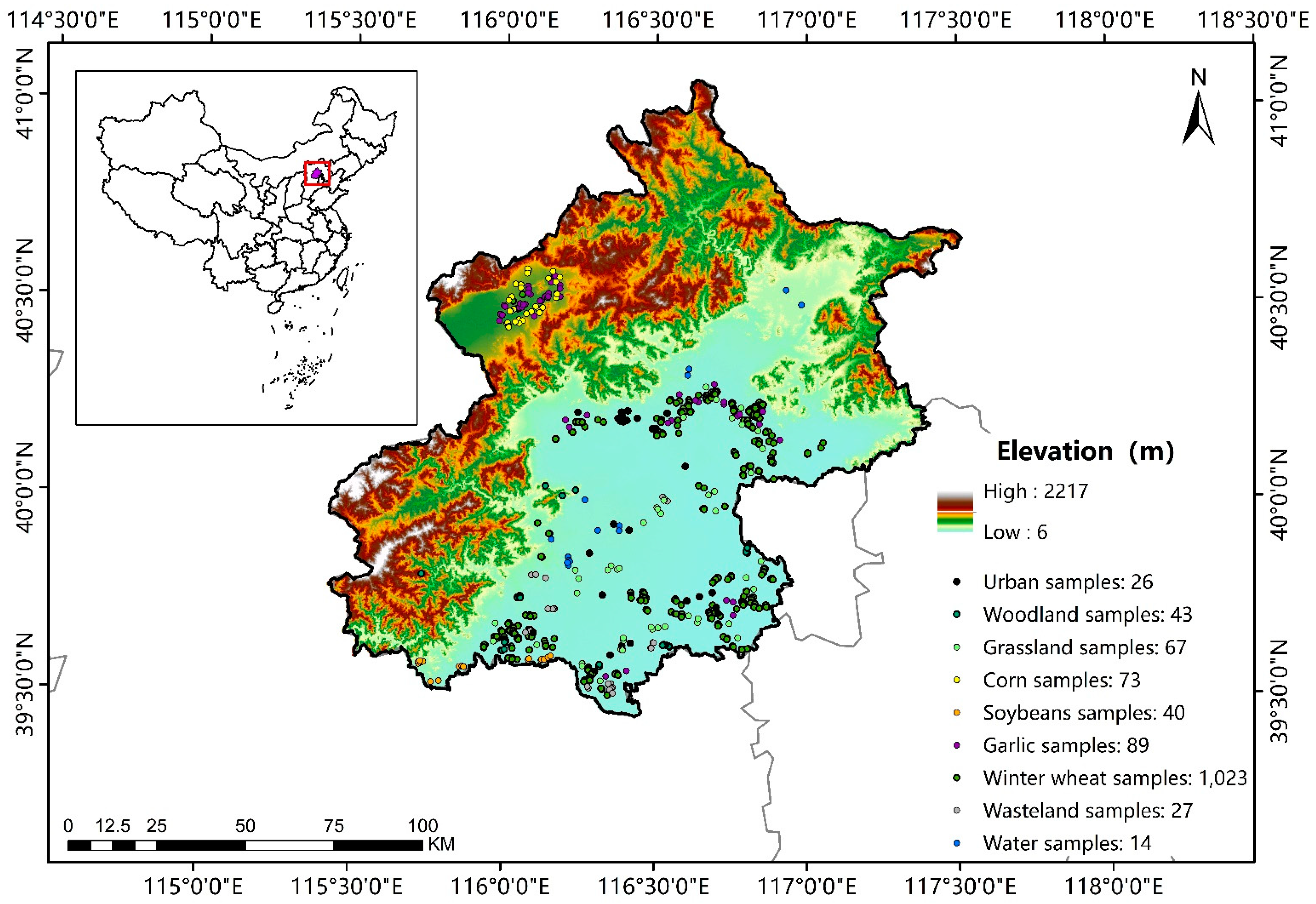
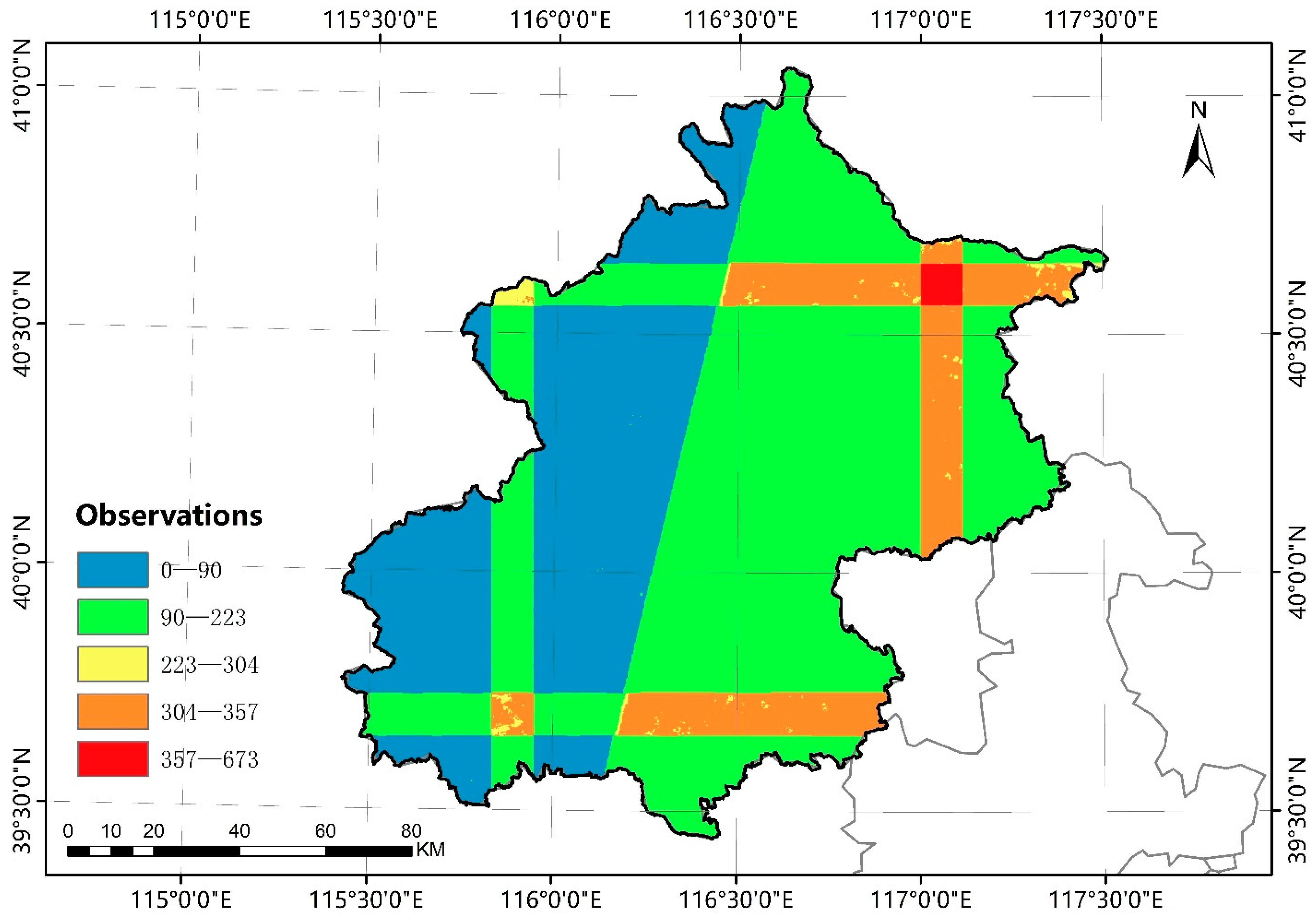
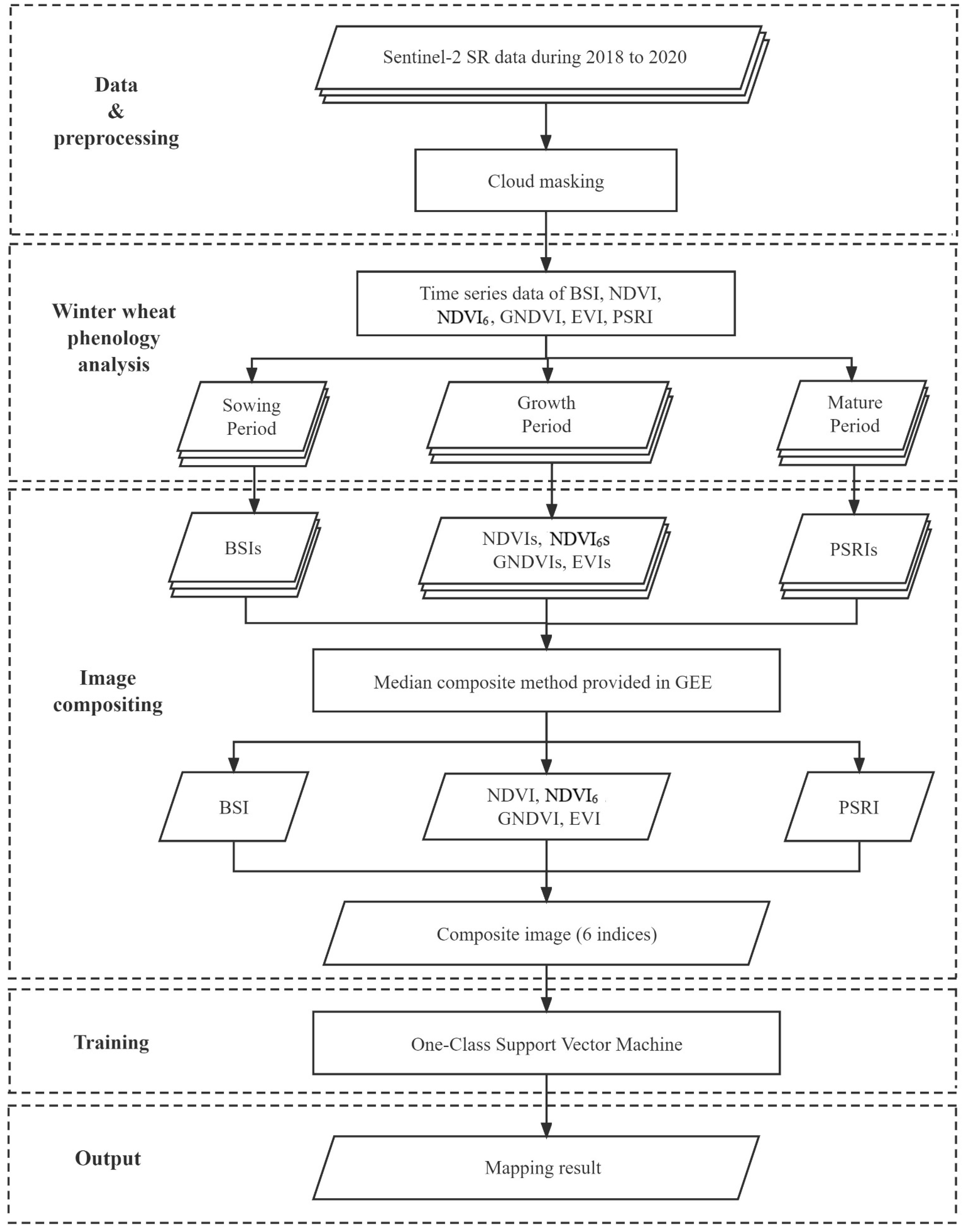

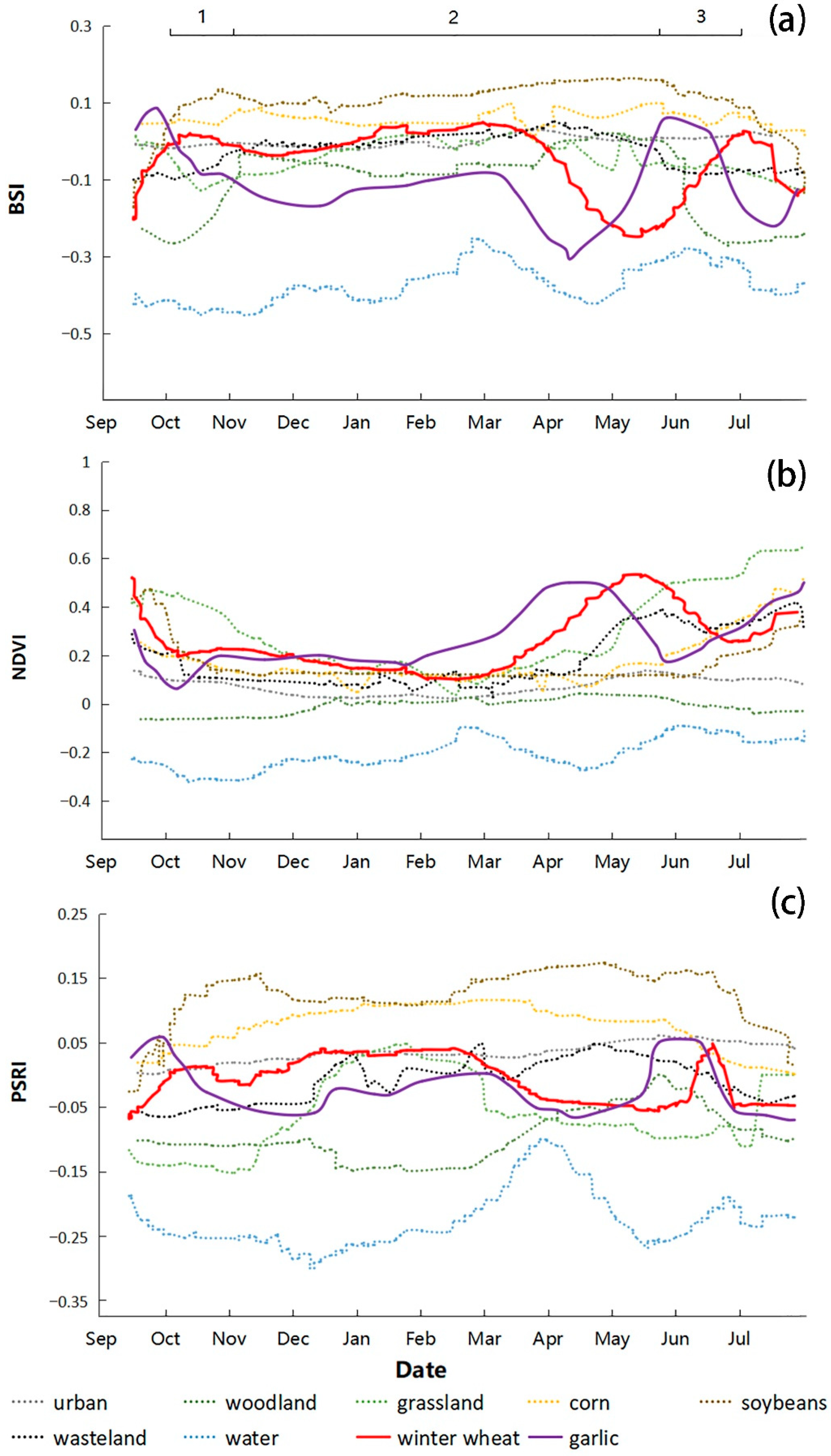
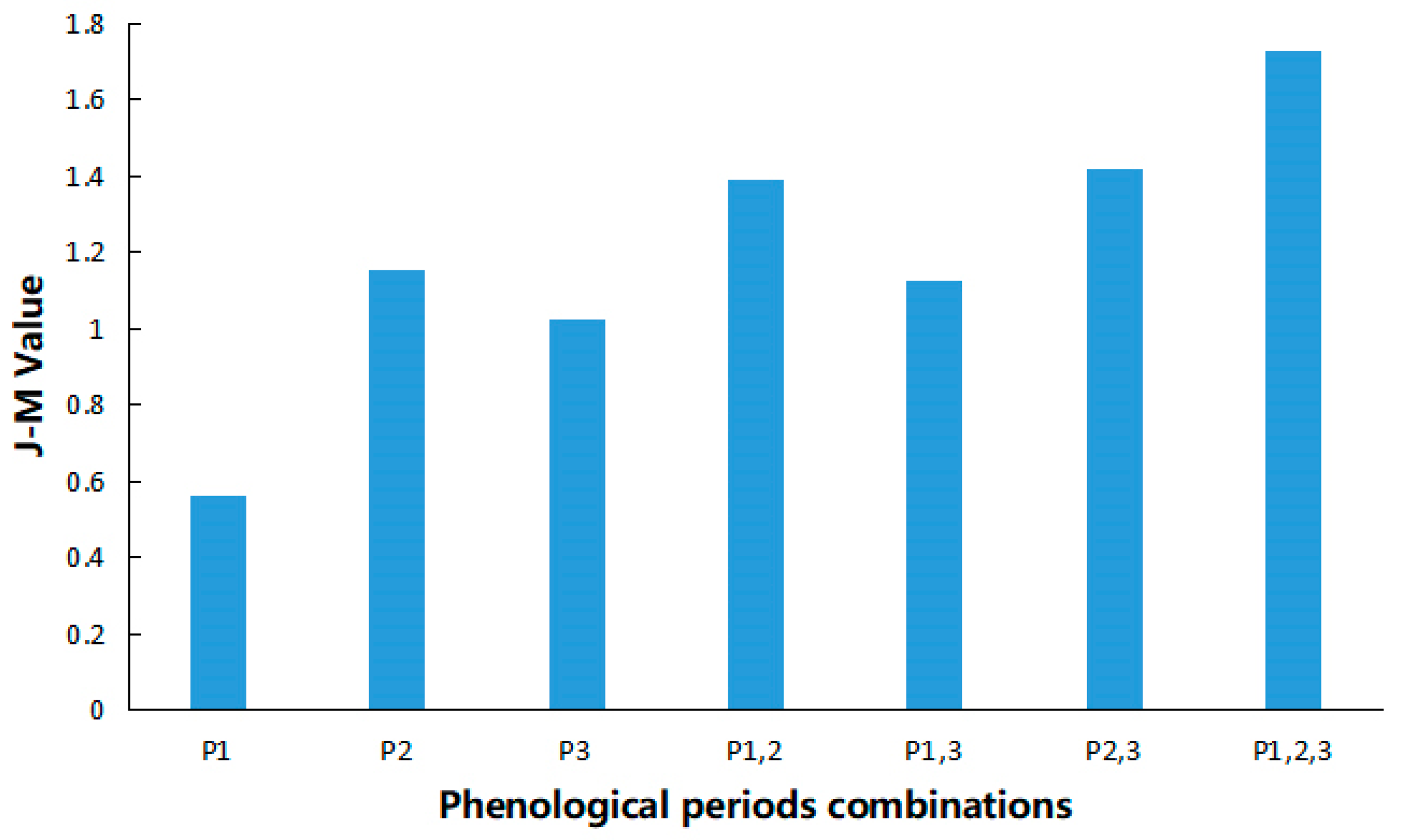
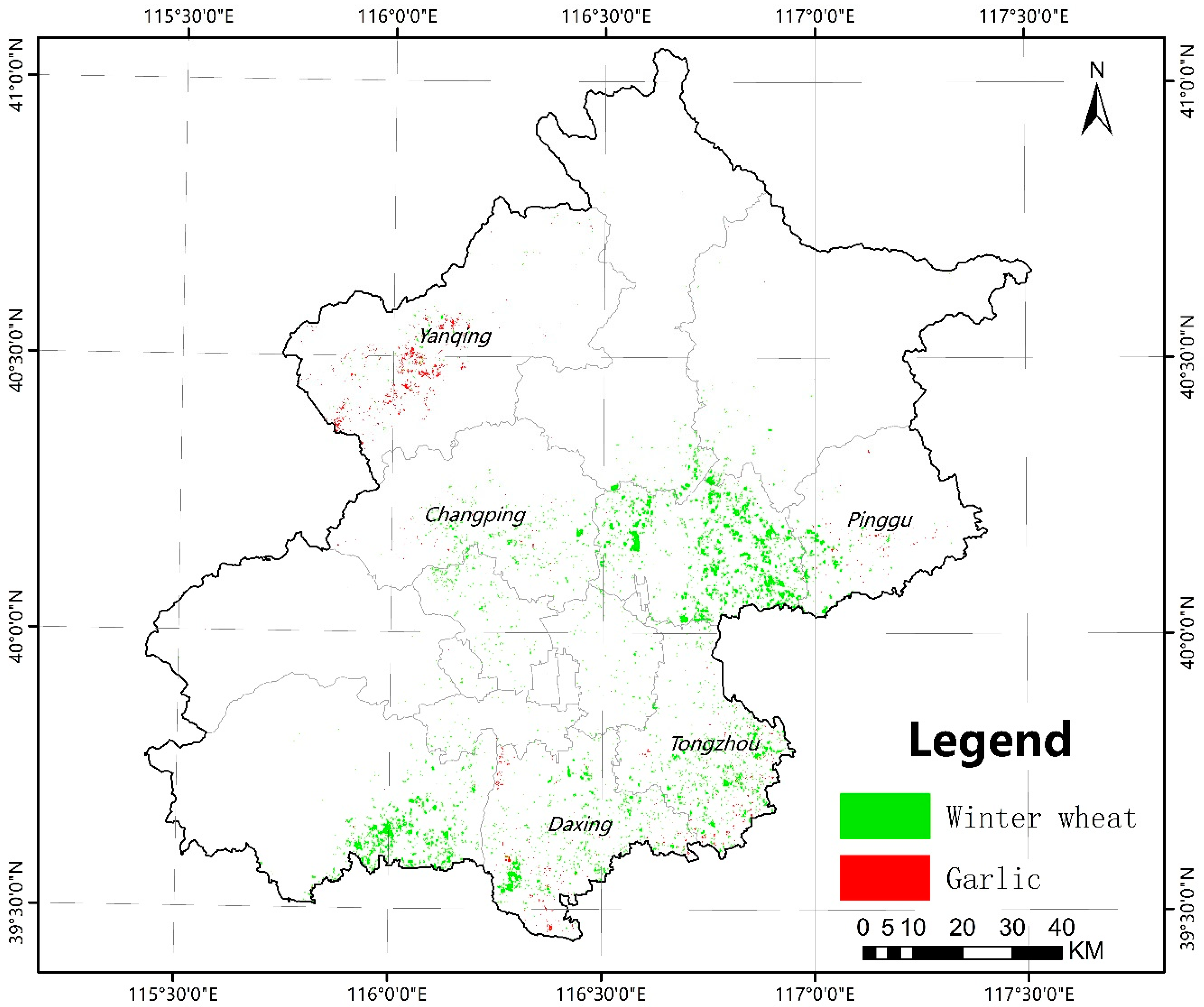



| Dataset | Class | Shunyi | Fangshan | Daxing | Tongzhou | Pinggu | Huairou | Miyun | Haidian | Changping | Chaoyang | Yanqing |
|---|---|---|---|---|---|---|---|---|---|---|---|---|
| training | winter wheat | 121 | 106 | 109 | 87 | 31 | 25 | 11 | 9 | 6 | 5 | 3 |
| validation | winter wheat | 120 | 106 | 108 | 86 | 31 | 26 | 12 | 8 | 5 | 5 | 3 |
| non-winter wheat | 47 | 42 | 31 | 4 | 2 | 2 | 2 | 1 | 2 | 1 | 1 |
| Spectral Indices | Calculation Formulas | Phenological Periods |
|---|---|---|
| BSI [37] | BSI = [(SWIR + R) − (NIR + B)]/ [(SWIR + R) + (NIR + B)] | Sowing period |
| NDVI [38] | NDVI = (NIR − R)/(NIR + R) | Growth period |
| GNDVI [39] | GNDVI = (NIR − G)/(NIR + G) | Growth period |
| NDVI6 [40] | NDVI6 = (6 × NIR − R)/ (NIR + 6 × R) | Growth period |
| EVI [41,42] | EVI = [2.5 × (NIR − R)]/ (NIR + 6 × R − 7.5 × B + 1) | Growth period |
| PSRI [34] | PSRI = (R − B)/Red Edge 2 | Mature period |
| The Combinations of Phenological Periods | Indices | Representation |
|---|---|---|
| Sowing | BSI | P1 |
| Growth | NDVI, GNDVI, NDVI6, EVI | P2 |
| Mature | PSRI | P3 |
| Sowing, Growth | BSI, NDVI, GNDVI, NDVI6, EVI | P1,2 |
| Sowing, Mature | BSI, PSRI | P1,3 |
| Growth, Mature | NDVI, GNDVI, NDVI6, EVI, PSRI | P2,3 |
| Sowing, Growth, Mature | BSI, NDVI, GNDVI, NDVI6, EVI, PSRI | P1,2,3 (Mpsf) |
| Argument | Type | Value |
|---|---|---|
| decisionProcedure | String | Default: “Voting” |
| svmType | String | “ONE_CLASS” |
| kernelType | String | RBF |
| shrinking | Boolean | Default: “true” |
| degree | Integer | Default: “null” |
| gamma | Float | 5.0 |
| coef0 | Float | Default: “0” |
| cost | Float | Default: “1” |
| nu | Float | 0.1 |
| terminationEpsion | Float | Default: “0.001” |
| lossEpsilon | Float | Default: “0.1” |
| oneClass | Integer | Default: “0” |
| Region | Class | Ground Truth Samples (Pixels) | PA (%) | UA (%) | OA (%) | Kappa | |
|---|---|---|---|---|---|---|---|
| Winter Wheat | Garlic | ||||||
| Yanqing | Winter wheat | 32 | 681 | 30.48 | 4.49 | 79.15 | 0.03 |
| Garlic | 73 | 2831 | 80.61 | 97.49 | |||
| Pinggu | Winter wheat | 203 | 48 | 33.66 | 80.87 | 33.23 | −0.11 |
| Garlic | 400 | 20 | 29.41 | 4.76 | |||
| Daxing | Winter wheat | 417 | 127 | 40.80 | 76.65 | 50.27 | 0.10 |
| Garlic | 605 | 323 | 71.78 | 34.81 | |||
| Changping | Winter wheat | 89 | 33 | 34.23 | 72.95 | 41.04 | −0.03 |
| Garlic | 171 | 53 | 61.63 | 23.67 | |||
| Tongzhou | Winter wheat | 352 | 327 | 44.67 | 51.84 | 46.49 | −0.06 |
| Garlic | 436 | 311 | 48.75 | 41.63 | |||
| Region | Class | Ground Truth Samples (Pixels) | PA (%) | UA (%) | OA (%) | Kappa | |
|---|---|---|---|---|---|---|---|
| Winter Wheat | Non-Wheat | ||||||
| Beijing | Winter wheat | 77,967 | 1045 | 90.05 | 98.68 | 97.97 | 0.93 |
| Non-wheat | 8618 | 388,803 | 99.73 | 97.83 | |||
| Fangshan | Winter wheat | 10,448 | 62 | 92.22 | 99.41 | 98.61 | 0.95 |
| Non-wheat | 882 | 56,601 | 99.89 | 98.47 | |||
| Shunyi | Winter wheat | 34,033 | 108 | 96.98 | 99.68 | 99.05 | 0.98 |
| Non-wheat | 1058 | 88,114 | 99.88 | 98.81 | |||
| Daxing | Winter wheat | 9493 | 635 | 92.84 | 93.73 | 98.81 | 0.93 |
| Non-wheat | 732 | 103,545 | 99.39 | 99.30 | |||
| Tongzhou | Winter wheat | 8211 | 52 | 85.69 | 99.37 | 97.38 | 0.90 |
| Non-wheat | 1371 | 44,730 | 99.88 | 97.03 | |||
| Pinggu | Winter wheat | 7328 | 37 | 85.18 | 99.50 | 97.31 | 0.90 |
| Non-wheat | 1275 | 40,172 | 99.91 | 96.92 | |||
| Huairou | Winter wheat | 3034 | 21 | 72.81 | 99.31 | 95.12 | 0.81 |
| Non-wheat | 1133 | 19,455 | 99.89 | 94.50 | |||
| Miyun | Winter wheat | 2691 | 18 | 70.85 | 99.34 | 94.78 | 0.80 |
| Non-wheat | 1107 | 17,731 | 99.90 | 94.12 | |||
| Haidian | Winter wheat | 1227 | 9 | 68.82 | 99.27 | 94.42 | 0.78 |
| Non-wheat | 556 | 8,326 | 99.89 | 93.74 | |||
| Changping | Winter wheat | 1137 | 6 | 80.07 | 99.48 | 96.41 | 0.87 |
| Non-wheat | 283 | 6629 | 99.91 | 95.91 | |||
| Chaoyang | Winter wheat | 298 | 8 | 61.33 | 97.36 | 92.89 | 0.71 |
| Non-wheat | 186 | 2239 | 99.64 | 92.33 | |||
| Yanqing | Winter wheat | 70 | 2 | 66.67 | 97.22 | 93.78 | 0.76 |
| Non-wheat | 35 | 488 | 99.59 | 93.31 | |||
| Year | Mapping Result (km2) | BBS (km2) | Relative Error (%) |
|---|---|---|---|
| 2019 | 84.85 | 84.42 | 0.51 |
| 2020 | 80.40 | 5.53 |
Publisher’s Note: MDPI stays neutral with regard to jurisdictional claims in published maps and institutional affiliations. |
© 2022 by the authors. Licensee MDPI, Basel, Switzerland. This article is an open access article distributed under the terms and conditions of the Creative Commons Attribution (CC BY) license (https://creativecommons.org/licenses/by/4.0/).
Share and Cite
Cai, W.; Tian, J.; Li, X.; Zhu, L.; Chen, B. A New Multiple Phenological Spectral Feature for Mapping Winter Wheat. Remote Sens. 2022, 14, 4529. https://doi.org/10.3390/rs14184529
Cai W, Tian J, Li X, Zhu L, Chen B. A New Multiple Phenological Spectral Feature for Mapping Winter Wheat. Remote Sensing. 2022; 14(18):4529. https://doi.org/10.3390/rs14184529
Chicago/Turabian StyleCai, Wenxin, Jinyan Tian, Xiaojuan Li, Lin Zhu, and Beibei Chen. 2022. "A New Multiple Phenological Spectral Feature for Mapping Winter Wheat" Remote Sensing 14, no. 18: 4529. https://doi.org/10.3390/rs14184529
APA StyleCai, W., Tian, J., Li, X., Zhu, L., & Chen, B. (2022). A New Multiple Phenological Spectral Feature for Mapping Winter Wheat. Remote Sensing, 14(18), 4529. https://doi.org/10.3390/rs14184529






